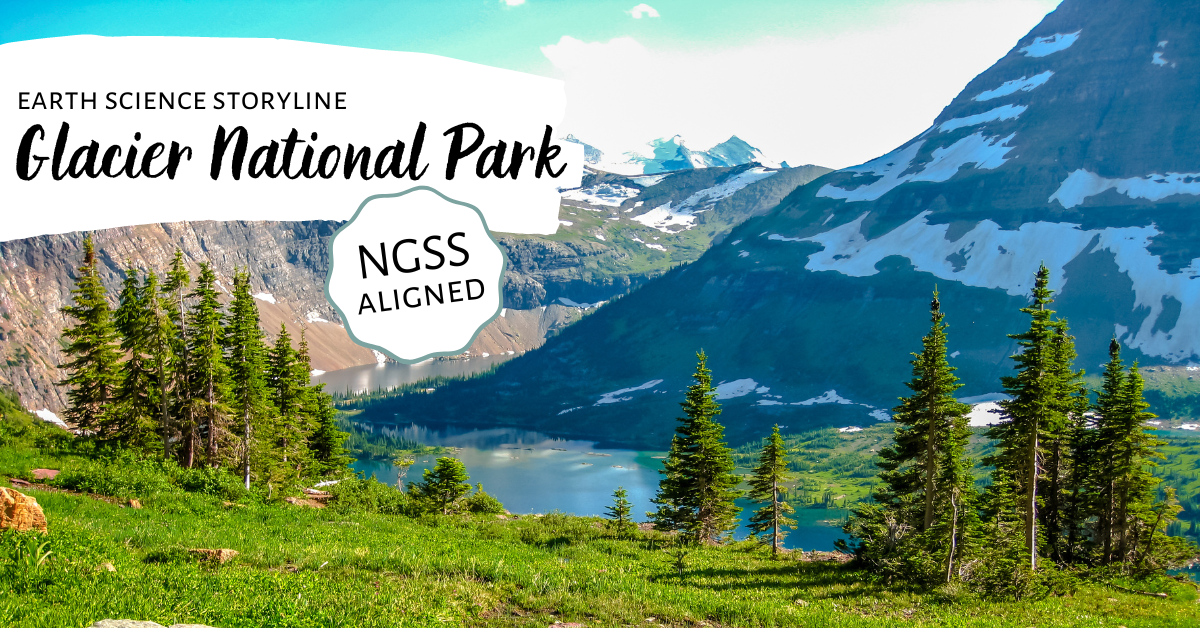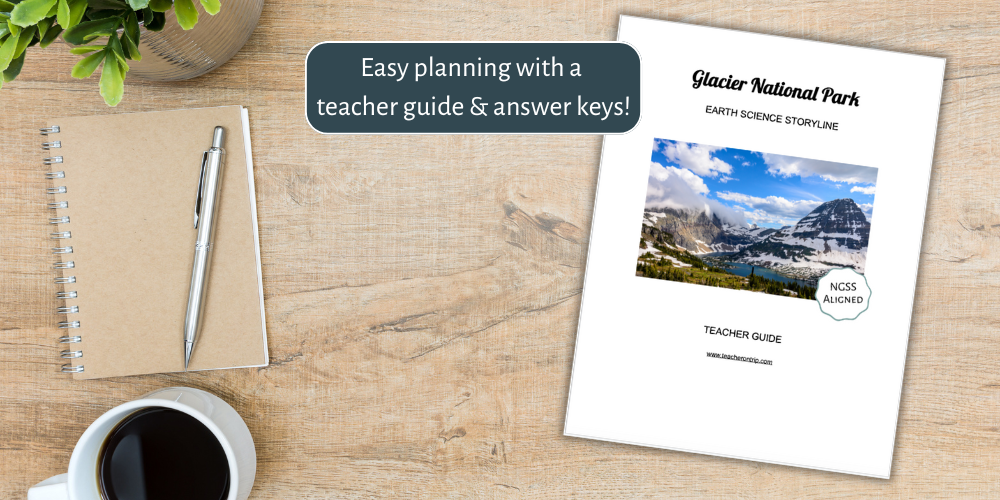NGSS Earth Science Curriculum: Glacier NP

What is a Storyline?
An NGSS Earth science storyline is an intentionally sequenced series of lessons that begins with a phenomenon, encourages student investigations to discover findings, and assesses student learning in three dimensions.
Yes, three dimensions! In an NGSS aligned classroom, students are learning more than just content. So, what are these three dimensions?
- Dimension 1: Science & Engineering Practices – What students are doing
- Dimension 2: Crosscutting Concepts – How students are thinking and making connections
- Dimension 3: Disciplinary Core Ideas – What students are learning
You can take a real deep dive into reading more about and the origin of the 3-Dimensions in the Framework of K-12 Science Education.

Why use NGSS Earth Science Storylines?
NGSS storylines are less “teaching as telling” and more student-led discovery. The teacher becomes the facilitator and students take on more responsibility for their own learning. This is not a teaching fad that will come and go faster than fashion styles change. This is a real-deal transformation in how we teach and how our students learn.
Students’ confidence in their science abilities grow as they learn more through doing science. That’s the NGSS difference.
Performance Expectations
The following performance expectations are covered in Glacier NP Storyline.
HS-ESS2-2: Analyze geoscience data to make the claim that one change to Earth’s surface can create feedbacks that cause changes to other Earth systems.
HS-ESS2-4: Use a model to describe how variations in the flow of energy into and out of Earth’s system result in changes in climate.
HS-ESS2-6: Use a quantitative model to describe the cycling of carbon among the hydrosphere, atmosphere, geosphere, and biosphere.
HS-ESS3-5: Analyze geoscience data and the results from global climate models to make an evidence-based forecast of the current rate of global or regional climate change and associated future impacts to Earth systems.
HS-ESS3-6: Use a computational representation to illustrate the relationships among Earth systems and how those relationships are being modified due to human activity.
Disciplinary Core Ideas
What Students Learn
The following Disciplinary Core Ideas are covered in Glacier NP Storyline. Descriptions are from the Next Gen Science Standards App.
ESS2.A: Earth Materials and Systems
- Earth’s systems, being dynamic and interacting, cause feedback effects that can increase or decrease the original changes.
ESS2.D: Weather and Climate
- Current models predict that, although future regional climate changes will be complex and varied, average global temperatures will continue to rise. The outcomes predicted by global climate models strongly depend on the amounts of human-generated greenhouse gases added to the atmosphere each year and by the ways in which these gases are absorbed by the ocean and biosphere.
ESS3.D: Global Climate Change
- Though the magnitudes of human impacts are greater than they have ever been, so too are human abilities to model, predict, and manage current and future impacts.
Science & Engineering Practices
What Students Do
The following Science & Engineering Practices are incorporated in the Hawaii Volcanoes NP Storyline. Descriptions are from the Next Gen Science Standards App.
Developing and Using Models
- Develop a model based on evidence to illustrate the relationships between systems or between components of a system.
Engage in Argument From Evidence
- Evaluate evidence behind currently accepted explanations or solutions to determine the merits of arguments.
Constructing Explanations and Designing Solutions
- Construct an explanation based on valid and reliable evidence obtained from a variety of sources (including students own investigations, models, theories, simulations, peer review) and the assumption that theories and laws that describe the natural world operate today as they did in the past and will continue to do so in the future.
Using Mathematics and Computational Thinking
- Mathematical and computational thinking in 9-12 builds on K-8 experiences and progresses to using algebraic thinking and analysis, a range of linear and nonlinear functions including trigonometric functions, exponentials and logarithms, and computational tools for statistical analysis to analyze, represent, and model data. Simple computational simulations are created and used based on mathematical models of basic assumptions.
The above science & engineering practices are emphasized throughout the storyline, however additional science & engineering practices are also included.
Crosscutting Concepts
How Students Think & Process
The following Crosscutting Concepts are incorporated in the Hawaii Volcanoes NP Storyline. Descriptions are from the Next Gen Science Standards App.
Patterns
- Empirical evidence is needed to identify patterns
Stability and Change
- Change and rates of change can be quantified and modeled over very short or very long periods of time. Some system changes are irreversible
Energy and Matter
- Energy drives the cycling of matter within and between systems
Cause and Effect
- Empirical evidence is required to differentiate between cause and correlation and make claims about specific causes and effects.
Systems and System Models
- When investigating or describing a system, the boundaries and initial conditions of the system need to be defined and their inputs and outputs analyzed and described using models.
The above crosscutting concepts are emphasized throughout the storyline, however additional crosscutting concepts are also included.
Phenomenon
Storylines begin with phenomenon. This provides an equitable starting experience for all students and an opportunity for students to ask questions that we will investigate throughout the storyline.
Glacier NP Storyline starts with this series of images from the Glacier Repeat Photography Project.
Activities in Glacier NP NGSS Earth Science Storyline
Examples of activities:
- Develop driving questions based on phenomenon – images from the photography repeat project
- Read and communicate the value of glaciers
- Measure incoming and outgoing solar radiation
- Calculate the albedo of readily available surfaces
- Analyze and evaluate claims of causes of modern climate change
- Observe historical data recorded in ice cores
- Develop models showing impacts of different climate forcings
- Analyze models of future climate models
- Construct explanations about potential solutions to reduce effects of climate change
- Research and communicate local climate impacts and recommendations for mitigation/acclimation
Assessment in Glacier NP NGSS Earth Science Storyline
Students are learning differently in a NGSS aligned classroom, so how we assess them will look a little different as well. The assessment is more than a recall of information memorized during the unit. Students are assessed in all 3 dimensions, therefore they will need to apply their science practices and thinking skills utilized during the storyline.
Yes, students will be evaluated over what they learned. But, they will also be assessed over their understanding of processes by developing models, engaging in argument from evidence, and constructing explanations for novel phenomenon.
What’s Included with Glacier NP NGSS Earth Science Storyline?
When you purchase Glacier NP Storyline and add a motivated teacher, you’ll have nearly everything you need!
- Thorough Teacher Guide with daily lessons
- Printable in-person student worksheets
- Formative and summative assessments
- In-person supplement slides via Google SlidesTM
- Lab activities
- Materials list for each lesson
- Answer keys for in-person student worksheets & assessments
